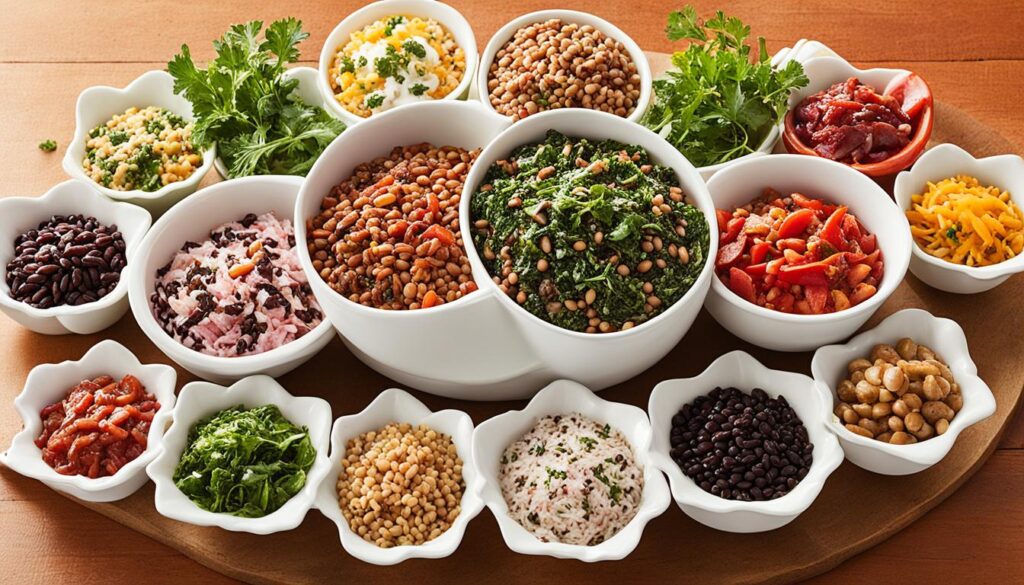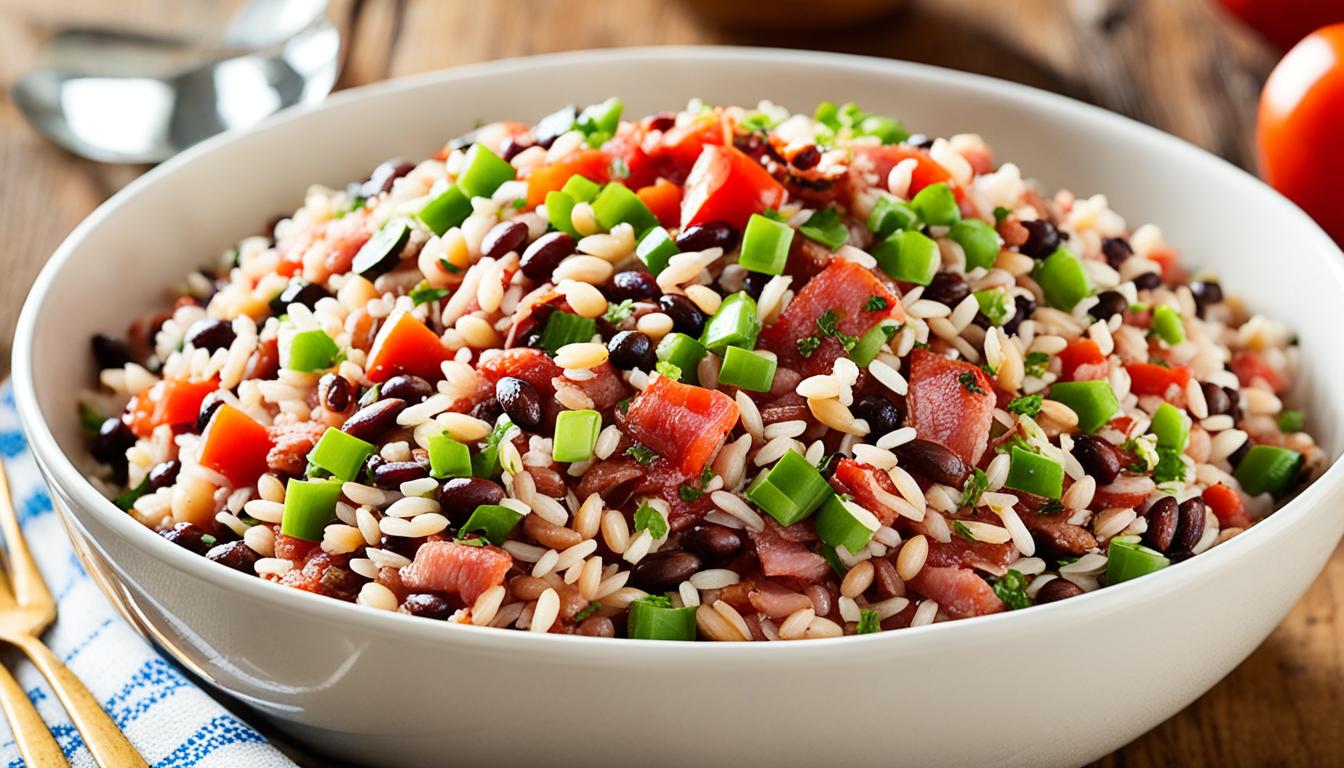Have you ever wondered why Hoppin John is such a popular dish on New Year’s Day? What is the story behind this Southern cuisine staple that combines black-eyed peas and rice? Is there any truth to the belief that it brings good luck and prosperity for the year ahead?
Hoppin John is not just a delicious rice dish; it holds a special place in Southern traditions and superstitions. This one-pot meal, with its humble ingredients and bold flavors, has become synonymous with New Year’s celebrations in the South. But there’s more to it than meets the eye. Join us as we explore the history, significance, and variations of Hoppin John, and discover the secrets behind its enduring popularity.
Key Takeaways:
- Hoppin John is a classic Southern dish made with black-eyed peas and rice, enjoyed on New Year’s Day as a tradition for good luck and prosperity.
- Its origins can be traced back to enslaved Africans who introduced black-eyed peas and rice to the Southern United States.
- There are various variations of Hoppin John recipes, allowing for different flavors and dietary preferences.
- Making Hoppin John is relatively simple and can be customized to individual preferences.
- The tradition of eating Hoppin John is steeped in superstitions and beliefs associated with wealth and fortune.
The History and Significance of Hoppin John
Hoppin John has a rich history and significant symbolism in Southern cuisine. It is believed to have originated in the southern United States, specifically North and South Carolina, as well as the Sea Islands. The dish is said to have been created by enslaved people from Africa, who brought black-eyed peas to America and cultivated them on rice plantations.
The ingredients in Hoppin John hold symbolic meaning. Black-eyed peas are believed to represent coins, while collard greens symbolize paper money, and cornbread represents gold. This combination of ingredients reflects the desire for prosperity and abundance in the New Year.
Hoppin John is traditionally eaten on New Year’s Day, as it is believed to bring luck and prosperity for the coming year. The dish’s symbolism and the belief surrounding it have made it a cherished tradition in Southern culture.
“Hoppin John is more than just a dish; it is a reflection of our history and the resilience of our ancestors. It represents the hopes and dreams for a prosperous future.”
While the basic recipe for Hoppin John consists of black-eyed peas and rice, variations of the dish have been developed over time. Some include additional ingredients, such as bacon or smoked pork, to enhance the flavor. These variations showcase the creative and diverse nature of Southern cuisine.
| Ingredient | Symbolism |
|---|---|
| Black-Eyed Peas | Coins and prosperity |
| Collard Greens | Paper money |
| Cornbread | Gold |
Variations of Hoppin John Recipes
When it comes to Hoppin John, there is no shortage of variations that cater to different flavors and dietary preferences. These variations add a delightful twist to the traditional Hoppin John recipe, allowing you to explore new tastes while honoring the essence of Southern cuisine.
One way to infuse exciting flavors into Hoppin John is by incorporating additional spices and seasonings. For instance, using ingredients like harissa, smoked paprika, and cumin can add a smoky and spicy kick to the dish. These spices elevate the flavor profile, creating a unique and robust Hoppin John experience.
If you’re looking for a vegetarian option, fear not! There are plenty of ways to enjoy Hoppin John sans bacon or pork. Vegetarian variations often incorporate ingredients like garlic, ginger, turmeric, curry powder, and tomatoes to enhance the savory and nutty notes of the dish. These elements come together to create a delightful vegetarian rendition of this classic Southern recipe.
In fact, some renowned chefs have put their own spin on Hoppin John, pushing the boundaries of flavor and creativity. Take, for example, Nashville chef Sean Brock. He elevates the dish by topping it with a luscious thick pea gravy and delectable smoked oysters. This indulgent twist takes Hoppin John to a whole new level of culinary decadence, pleasing both the taste buds and the eyes.
Explore the versatile world of Hoppin John variations, where traditional recipes meet new spice combinations and vegetarian options. Don’t be afraid to experiment and add your own unique touch to this beloved Southern dish!

| Variation | Description |
|---|---|
| Spicy Hoppin John | Incorporates harissa, smoked paprika, and cumin to add a fiery kick to the dish. |
| Vegetarian Hoppin John | A meat-free version that replaces bacon or pork with flavorful ingredients like garlic, ginger, and turmeric. |
| Indulgent Hoppin John with Pea Gravy and Smoked Oysters | A unique creation by chef Sean Brock, featuring a thick pea gravy and succulent smoked oysters as toppings. |
How to Make Hoppin John
Making Hoppin John is relatively simple, making it an accessible recipe for both experienced cooks and beginners. The basic ingredients include black-eyed peas, rice, and various seasonings. The black-eyed peas can be cooked from dried or used from canned options.
The dish typically begins by sautéing onions and garlic, then adding the black-eyed peas, rice, and seasonings. These are simmered until the liquid is absorbed and the rice is tender. The dish can be customized to individual preferences by adding additional spices or ingredients such as bacon or vegetables. The final result is a hearty and flavorful one-pot meal that can be enjoyed on its own or as a side dish.
Cooking Instructions: Step-by-Step Guide
- Sauté onions and garlic: In a large pot, heat some oil over medium heat. Add diced onions and minced garlic, and sauté until fragrant and golden brown.
- Add black-eyed peas and rice: Once the onions and garlic are cooked, add the black-eyed peas and rice to the pot. Stir well to combine.
- Add seasonings: Season the mixture with salt, pepper, and any additional spices or herbs of your choice. Some popular additions include thyme, paprika, cayenne pepper, and bay leaves.
- Simmer until tender: Pour enough water or vegetable broth into the pot to cover the mixture. Bring to a boil, then reduce the heat to low and cover the pot. Allow the Hoppin John to simmer for about 20-25 minutes, or until the liquid is absorbed, and the rice is tender.
- Adjust seasoning and serve: Taste the Hoppin John and adjust the seasoning if needed. You can add more salt, pepper, or spices according to your preference. Serve hot and enjoy!
Ingredients:
- 2 cups black-eyed peas
- 1 cup rice
- 1 onion, diced
- 3 cloves garlic, minced
- Salt and pepper to taste
- Optional: Additional spices or herbs such as thyme, paprika, cayenne pepper, or bay leaves
Note: Feel free to customize your Hoppin John recipe by adding other ingredients like diced tomatoes, bell peppers, or cooked bacon for added flavor and texture.
The Tradition of Hoppin John and Its Superstitious Beliefs
The tradition of eating Hoppin John on New Year’s Day is deeply rooted in superstitions and beliefs for good luck and prosperity. Many believe that consuming this dish on the first day of the year will bring wealth and fortune in the coming months.
There are various customs and superstitious practices associated with Hoppin John, such as adding a dime to the dish and counting the number of black-eyed peas on the plate to determine one’s luck or wealth.
“We always make sure to add a dime to our Hoppin John, symbolizing the hope for financial prosperity and good fortune in the new year,” says Mary Johnson, a lifelong advocate of the tradition.
Additionally, Hoppin John is often served with collard greens and cornbread, which further symbolize wealth and good fortune. This is known as “The Trinity of Prosperity” in Southern culture, where each component of the meal represents a different aspect of prosperity – black-eyed peas for coins, collard greens for paper money, and cornbread for gold.
| Superstition or Practice | Meaning |
|---|---|
| Adding a dime to the dish | Symbolizes hope for financial prosperity |
| Counting the number of black-eyed peas on the plate | Indicates luck and wealth for the coming year |
The dish’s history, symbolism, and superstitious beliefs have made it an enduring tradition in Southern culture. It is a time-honored way of welcoming the new year and inviting good luck and prosperity into our lives.
Embrace the tradition of Hoppin John and celebrate the new year with a dish that brings not only delicious flavors but also the hope for a prosperous future.
Conclusion
Hoppin John is a beloved Southern dish that holds a special place in New Year’s traditions. The combination of black-eyed peas, rice, and flavorful seasonings has made it a staple on this auspicious day. It is believed that consuming this dish brings good luck and prosperity for the coming year, making it a must-have for many families.
Not only does Hoppin John symbolize Southern cuisine at its finest, but it also showcases the diversity and versatility of the region’s culinary heritage. From the traditional recipe passed down through generations to the unique variations created by innovative chefs, this rice dish truly captures the essence of Southern flavors.
Whether you choose to prepare the classic Hoppin John recipe or experiment with different ingredients and spices, this delightful dish promises a delightful culinary experience. Its nutty and savory flavors, coupled with the health benefits of black-eyed peas, make it a wholesome and satisfying choice for any occasion. So why not embrace the charm of Southern cuisine and incorporate Hoppin John into your New Year’s Day celebrations?
Let the rich history, symbolism, and superstitions surrounding Hoppin John propel you into a year of prosperity and abundance. As you savor each spoonful of this soul-warming dish, may the black-eyed peas bless you with good fortune and the rice fill your life with nourishment and success. Start your year off right with the taste of Southern tradition and experience the magic of Hoppin John.
